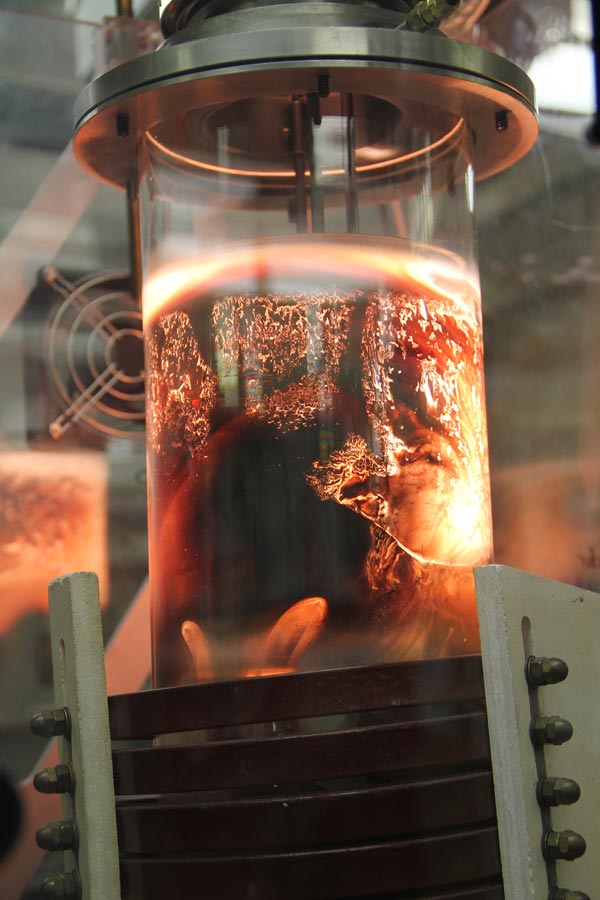New CMI Process Recycles Valuable Rare Earth Metals From Old Electronics

U.S. Dept. of Energy's Ames Laboratory Scientists at the Critical Materials Institute at Ames Laboratory have developed a new process to recycle rare earth metals easier and cheaper. Here, magnesium is melted with rare-earth magnet scrap in an induction furnace.
Rare-earth metals are valuable ingredients in a variety of modern technologies and are found in cell phones, hard disk drives in computers, and other consumer electronics, which are frequently discarded for newer and more up-to-date versions.
According to the Environmental Protection Agency, U.S. consumers disposed of 3.4 million tons of electronics waste in 2012. Continuously increasing global demand for new consumer electronics in turn drives demand for rare-earth metals, which are difficult and costly to mine.
But recycling rare earths isn’t necessarily any easier.
“Recycling rare-earth metals out of consumer waste is problematic, and there are multiple obstacles in the entire chain from manufacturing to collection infrastructure to sorting and processing,” said CMI scientist Ryan Ott. “We’re looking at ways to make the processing part of that chain—removing the rare-earths from scrap magnet material—better.”
Building upon previous research work done at the Ames Laboratory, Ott and his research group have developed a two-stage liquid metal extraction process that uses differences between the solubility properties of different elements to separate out rare-earth metals.
“Magnesium has good solubility with rare-earths, particularly with neodymium, and poor solubility with the other components of magnets, like iron and boron,” said Ott.
In the liquid extraction method CMI has developed, scrap metals are melted with magnesium. The lighter atomic weight rare earths like neodymium bind with the magnesium and leave the iron scrap and other materials behind. Then the rare earths are recovered from the magnesium through vacuum distillation.
In the second step, another material is used to bind with and extract the heavier atomic weight rare earths, like dysprosium.
Finding the best way to do the second step was the important breakthrough, Ott said.
“Extraction of the heavier rare earths was always the difficulty of this process, and those materials are the most valuable. So finding a way to do that successfully was the key to making it more economically viable as a large-scale recycling method.”
Developing economical recycling methods to reduce waste of rare-earth materials– which are critical to clean energy technologies like electric vehicles, wind turbines and energy-efficient lighting– will boost U.S. manufacturing competitiveness and energy security.
For information regarding the licensing of this technology, contact Craig Forney at Iowa State University's Office of Intellectual Property and Technology Transfer, 515-294-9513, ceforney@iastate.edu.
The Critical Materials Institute is a Department of Energy Innovation Hub led by the U.S. Department of Energy's Ames Laboratory. CMI seeks ways to eliminate and reduce reliance on rare-earth metals and other materials critical to the success of clean energy technologies.
Ames Laboratory is a U.S. Department of Energy Office of Science national laboratory operated by Iowa State University. Ames Laboratory creates innovative materials, technologies and energy solutions. We use our expertise, unique capabilities and interdisciplinary collaborations to solve global problems.
Ames Laboratory is supported by the Office of Science of the U.S. Department of Energy. The Office of Science is the single largest supporter of basic research in the physical sciences in the United States, and is working to address some of the most pressing challenges of our time. For more information, please visit science.energy.gov.
Contact Information
Breehan Gerleman Lucchesi
Communications specialist
breehan@ameslab.gov
Phone: 515-294-9750
Media Contact
All latest news from the category: Process Engineering
This special field revolves around processes for modifying material properties (milling, cooling), composition (filtration, distillation) and type (oxidation, hydration).
Valuable information is available on a broad range of technologies including material separation, laser processes, measuring techniques and robot engineering in addition to testing methods and coating and materials analysis processes.
Newest articles

Bringing bio-inspired robots to life
Nebraska researcher Eric Markvicka gets NSF CAREER Award to pursue manufacture of novel materials for soft robotics and stretchable electronics. Engineers are increasingly eager to develop robots that mimic the…

Bella moths use poison to attract mates
Scientists are closer to finding out how. Pyrrolizidine alkaloids are as bitter and toxic as they are hard to pronounce. They’re produced by several different types of plants and are…

AI tool creates ‘synthetic’ images of cells
…for enhanced microscopy analysis. Observing individual cells through microscopes can reveal a range of important cell biological phenomena that frequently play a role in human diseases, but the process of…





















